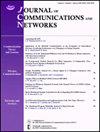An efficient tasks offloading procedure for an integrated edge-computing architecture
IF 3.2
3区 计算机科学
Q2 COMPUTER SCIENCE, INFORMATION SYSTEMS
引用次数: 0
Abstract
The advent of sixth-generation networks has given rise to numerous challenges, requiring the synergistic exploitation of both ground and air edge computing facilities. This paper considers an integrated ground-air edge computing scenario where the computation offloading of a set of delay sensitive tasks has to be performed in a context where ground and air computational facilities are already involved in monitoring and control proceduers in a remote area under an unpredictable overload of computation requests, e.g., related to the management of an emergency situation. In this reference, a matching game is proposed to assign tasks to the most suitable computation nodes, in order to minimize the outage probability of the newly arrived tasks, i.e., the probability with which tasks experience a completion time greater than the corresponding deadline. To this regard, we have considered that new allocated task suffer for a waiting time due to the time needed to complete the service of all the tasks already in the ground or air computation node. As a consequence, to statistically characterize such waiting time, under proper assumptions, we have resorted to the G/G/1 queuing system model and the Lindley's integral equation approach to define a suitable metric to formulate a tasks allocation procedure based on the matching theory. Furthermore, matching stability has been theoretically proved for the proposed approach. Finally, numerical results have been provided in order to highlight the better behavior of the proposed task allocation scheme in comparison with different state-of-the-art alternatives.集成边缘计算架构的高效任务卸载程序
第六代网络的出现带来了众多挑战,需要协同利用地面和空中的边缘计算设施。本文考虑了一种地空一体化边缘计算场景,在这种场景下,地面和空中计算设施已经参与到偏远地区的监控程序中,在不可预测的超负荷计算请求(例如与紧急情况管理相关的计算请求)下,必须对一组延迟敏感任务进行计算卸载。在这一参考文献中,我们提出了一种匹配博弈方法,将任务分配给最合适的计算节点,以尽量减少新到达任务的中断概率,即任务完成时间大于相应截止时间的概率。为此,我们考虑到新分配的任务由于需要时间来完成已在地面或空中计算节点中的所有任务的服务,因此需要等待一段时间。因此,为了在适当的假设条件下统计这种等待时间的特征,我们采用了 G/G/1 队列系统模型和林德利积分方程方法来定义一个合适的度量,以制定基于匹配理论的任务分配程序。此外,我们还从理论上证明了拟议方法的匹配稳定性。最后,还提供了数值结果,以突出所提任务分配方案与最先进的其他方案相比具有更好的性能。
本文章由计算机程序翻译,如有差异,请以英文原文为准。
求助全文
约1分钟内获得全文
求助全文
来源期刊
CiteScore
6.60
自引率
5.60%
发文量
66
审稿时长
14.4 months
期刊介绍:
The JOURNAL OF COMMUNICATIONS AND NETWORKS is published six times per year, and is committed to publishing high-quality papers that advance the state-of-the-art and practical applications of communications and information networks. Theoretical research contributions presenting new techniques, concepts, or analyses, applied contributions reporting on experiences and experiments, and tutorial expositions of permanent reference value are welcome. The subjects covered by this journal include all topics in communication theory and techniques, communication systems, and information networks. COMMUNICATION THEORY AND SYSTEMS WIRELESS COMMUNICATIONS NETWORKS AND SERVICES.

 求助内容:
求助内容: 应助结果提醒方式:
应助结果提醒方式:


